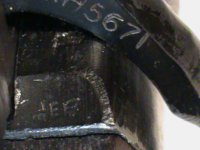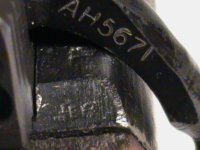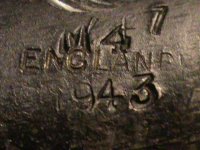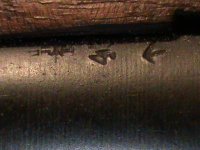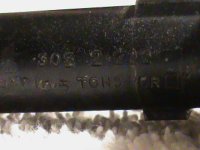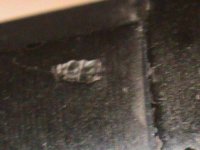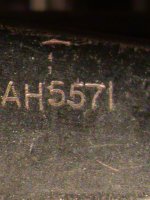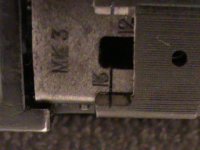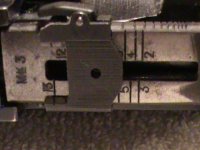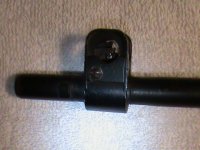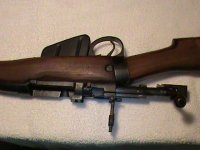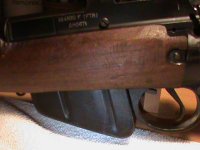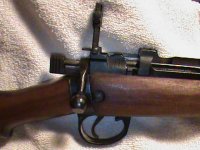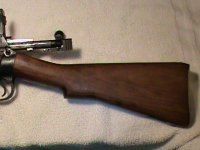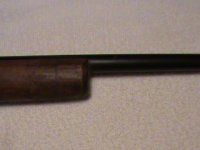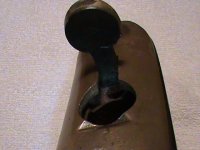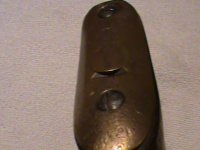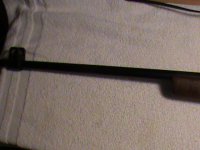You are using an out of date browser. It may not display this or other websites correctly.
You should upgrade or use an alternative browser.
You should upgrade or use an alternative browser.
An Interesting Enfield Rifle or Carbine? Can anyone identify it?
- Thread starter biggreddy
- Start date
m.p.driver
New member
Not much into British rifle markings but i would say British No.4 Mk1,BNP british nitro proof,maybe made by BSA in 43,rebuilt after the war by Fazakerley,FTR/factory thorough repair.Sold in 1990 at some gun show in the USA for $79,where bubba bought it and promptly cut the forearm down.But the good thing is wood is still readily available to replace it.
Mike Irwin
Staff
FTR means factory thorough refit. Basically reconditioned at a British arsenal.
If it's been in the family since 1950, that likely means that it was in the first wave of imports into the United States after World War II, and was purchased on the surplus market.
Or, it could have been brought back from the war as a trophy, althought that's not as likely given that it's an Allied gun as opposed to an Axis powers gun.
But, at some point in its like the stock was shortened, which was a pretty common "home gunsmithing" exercise.
A number of the markings "England" and "18.5 Tons" or whatever number that is, are consistent with British surplusing practices.
Nice close up photography, by the way. Most times we get closeups and they're unreadable.
If it's been in the family since 1950, that likely means that it was in the first wave of imports into the United States after World War II, and was purchased on the surplus market.
Or, it could have been brought back from the war as a trophy, althought that's not as likely given that it's an Allied gun as opposed to an Axis powers gun.
But, at some point in its like the stock was shortened, which was a pretty common "home gunsmithing" exercise.
A number of the markings "England" and "18.5 Tons" or whatever number that is, are consistent with British surplusing practices.
Nice close up photography, by the way. Most times we get closeups and they're unreadable.
mapsjanhere
New member
If you look at the pictures "stamp1", the British broadhead is not opposed as it would be with a properly surplussed rifle. Makes the "service memorabilia" story more likely.
Mike Irwin
Staff
I'm still thinking surplus due to the England and 18.5 Tons stamps.
As far as I know, those were put on when the gun was released from British service and sold to a private company for sale on the surplus market; otherwise, those stamps would not be on it.
As far as I know, those were put on when the gun was released from British service and sold to a private company for sale on the surplus market; otherwise, those stamps would not be on it.
I have no idea why the seeming conflilct. It is a Rifle No. 4 Mk I, made in 1943 at BSA, Birmingham (M47). Surplused out in the 1950's, it was proved at that time as required by British law before it could be sold on the civilian market. It was probably bought, along with hundreds of tons of others, by Interarmco or some other U.S. company, and sold in the U.S. for $14.95 plus S&H, by mail order. (A Rifle No.1, MK III went for $9.95.)
The "18.5" is part of the British commercial proof, and indicates the working pressure, in British tons, of the .303 cartridge it is chambered for (40,700 psi). The "ENGLAND" is the Country of Origin (COO) mark required of all goods imported into the U.S. at the time. The GCA '68 changed the law for firearms to require the "import mark" we have today. The COO mark was applied in bond in the U.S., and is not an "English export mark" as is often claimed.
At some point, probably at the end of the war and before being stored as a reserve weapon, it underwent FTR (Factory Thorough Repair) at the Royal Ordnance Factory (ROF), Fazakerly, a suburb of Liverpool.
It is nothing special, though in original condition, they bring a couple of hundred. They are good, serviceable rifles and reliable with the original .303 British cartridge.
Jim
The "18.5" is part of the British commercial proof, and indicates the working pressure, in British tons, of the .303 cartridge it is chambered for (40,700 psi). The "ENGLAND" is the Country of Origin (COO) mark required of all goods imported into the U.S. at the time. The GCA '68 changed the law for firearms to require the "import mark" we have today. The COO mark was applied in bond in the U.S., and is not an "English export mark" as is often claimed.
At some point, probably at the end of the war and before being stored as a reserve weapon, it underwent FTR (Factory Thorough Repair) at the Royal Ordnance Factory (ROF), Fazakerly, a suburb of Liverpool.
It is nothing special, though in original condition, they bring a couple of hundred. They are good, serviceable rifles and reliable with the original .303 British cartridge.
Jim
Mike Irwin
Staff
"The COO mark was applied in bond in the U.S., and is not an "English export mark" as is often claimed."
Interesting. It was always my understanding that the mark was applied in Britain.
Interesting. It was always my understanding that the mark was applied in Britain.
It can be applied either in the exporting country or in the US; in the case of those "first wave" Enfields, I watched workers at (then) Interarmco stamp it on rows and rows of rifles in the bonded warehouse. (FWIW, those guys were minimum wage workers, not gun experts, so sometimes you see Savage or Long Branch Nr. 4's stamped "ENGLAND".)
I got a PM asking what I meant by "bond", so I will take the opportunity to clear that up also. Just about all countries with ports allow the use of "bonded warehouses." These are warehouses that are physically on the soil of the country, but are considered to be legally outside the country. The owner of the warehouse has put up a stiff payment ("bond") as insurance against any goods from that warehouse coming into the country without the proper controls and payment of duties.
The advantage is that a company can use a bonded warehouse for transshipment; for example, goods from England can be stored in the U.S. while waiting shipment to Brazil without concern about U.S. duties or import laws, since legally the goods never enter the U.S. Another advantage is that a COO stamp, or an import mark, which has to be applied before goods can enter the U.S. can be applied "in bond". There is a special benefit for liquor importers, since they can store their product in bond, in bulk, and not pay any duty until it is broken down into retail packaging and released for sale, hence the term "bottled in bond" occasionally seen on liquor bottles.
Jim
I got a PM asking what I meant by "bond", so I will take the opportunity to clear that up also. Just about all countries with ports allow the use of "bonded warehouses." These are warehouses that are physically on the soil of the country, but are considered to be legally outside the country. The owner of the warehouse has put up a stiff payment ("bond") as insurance against any goods from that warehouse coming into the country without the proper controls and payment of duties.
The advantage is that a company can use a bonded warehouse for transshipment; for example, goods from England can be stored in the U.S. while waiting shipment to Brazil without concern about U.S. duties or import laws, since legally the goods never enter the U.S. Another advantage is that a COO stamp, or an import mark, which has to be applied before goods can enter the U.S. can be applied "in bond". There is a special benefit for liquor importers, since they can store their product in bond, in bulk, and not pay any duty until it is broken down into retail packaging and released for sale, hence the term "bottled in bond" occasionally seen on liquor bottles.
Jim
armsmaster270
New member
My N0. 4 MK 1 has the L rear sight for two ranges close & far not the MKIII ladder type rear sight. Yours has a lot better markings next to mine.
In the 50's Raley's supermarkets sold Enfield's in CA for $29.00


In the 50's Raley's supermarkets sold Enfield's in CA for $29.00


Mike Irwin
Staff
When I was a little kid, probably 1969 or 1970, I remember seeing racks of Enfields and other surplus rifles for sale at Joe the Motorist's Friend store.
Those were probably the tail end of the surplus that had come in just before enactment of GCA 1968.
I fell in love with the looks of the Enfield at that time, and it took me nearly 40 years until I was able to score a No 1 Mk III a few years ago. Indian made, but in gorgeous internal shape, and for $150, IIRC.
What REALLY sweetened the deal, though?
The very nice condition (metal and leather sheath) Pattern 1907 bayonet that came along with it.
I could probably sell the bayonet for at least $100.
Those were probably the tail end of the surplus that had come in just before enactment of GCA 1968.
I fell in love with the looks of the Enfield at that time, and it took me nearly 40 years until I was able to score a No 1 Mk III a few years ago. Indian made, but in gorgeous internal shape, and for $150, IIRC.
What REALLY sweetened the deal, though?
The very nice condition (metal and leather sheath) Pattern 1907 bayonet that came along with it.
I could probably sell the bayonet for at least $100.
Nice P 1907 bayonets are getting hard to find and expensive and some would go for more than $100. FWIW, the reason for the two cuts in the scales of the P 13 bayonet (copied in the U.S. M1917 bayonet) were so it could be quickly distinguished from the P 07 bayonet.
Jim
Jim
Mike Irwin
Staff
Mine unfortunately looks like someone tried to polish the metal on the scabbard and may have slapped a coat of varnish or shellac on the grips. They didn't do a good job on it, either.
Mine is stamped Anderson and has '3 and '36 stamps on it. No clue what they are.
At least they didn't take a grinder to the blade to try to sharpen it. I've seen that many times.
Attached to my No. 1, though? It just looks SO right.
Mine is stamped Anderson and has '3 and '36 stamps on it. No clue what they are.
At least they didn't take a grinder to the blade to try to sharpen it. I've seen that many times.
Attached to my No. 1, though? It just looks SO right.







